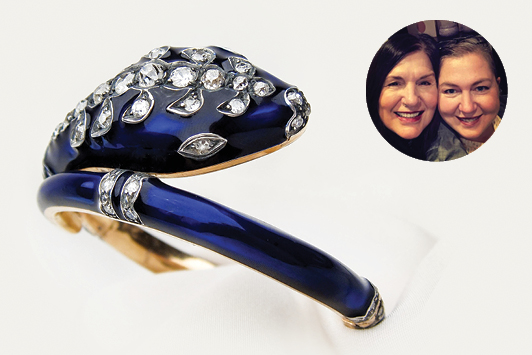
What are the most interesting features collectors look for in Victorian jewelry?
The Victorian era spanned nearly three-quarters of a century, from 1837 to 1901. Crafted in varying karats and colors of gold and sterling silver, pieces are distinguished by their fine detailing and high-quality artistry.
Sentimental Victorian themes varied greatly, from memorial jewelry, family crests, lockets and cameos, to cherubs, snakes and much more. Jewelry was sometimes small, intricate and dainty, and sometimes bold and dramatic. [Among the] stones used were beautifully cut precious diamonds, rubies, sapphires and emeralds, as well as amethysts, garnets, jet, onyx, turquoise, opal, pearl, citrines, coral, ivory, [and] tortoise shell banded agates.
The most popular cuts of the Victorian era included rose, cabochon, old mine and European. Hallmarks are very common and help to determine where the jewelry was made, the date, the city, the metal content and the maker. Jewelry that is hallmarked from all parts of Europe — including England, Russia, France, Denmark, Germany, Italy and Czechoslovakia — is in high demand.
Which categories are wearable today?
In dealing with antique jewelry enthusiasts for over 46 years, I have consistently found [that] all types of rings — especially snake rings (such as the type given to Queen Victoria by Prince Albert), symbolizing eternal love — are always a favorite, followed by Victorian gold earrings and necklaces. Also currently popular are festoon necklaces and garnet jewelry, mourning jewelry, enameled and engraved pieces.
Sterling silver from England — chains and lockets, engraved bangles and earrings — is perfect for those who prefer silver. The truth is, all Victorian jewelry is popular; its choice depends on the client’s preferences.
Are there categories on the market where copies are prevalent?
Copies and reproductions are prevalent in antique jewelry; one should always remain vigilant. However, because of the intricacies and uniqueness of Victorian jewelry, reproductions are less common in those pieces compared to later eras. The quality and craftsmanship in a piece of authentic Victorian jewelry is apparent because of the tools used, the abilities of the artisans, the cut of the stones, and mostly the rarity and detail of the designs. Keep in mind that original pieces from this era are handmade and therefore one of a kind. Modern jewelry that is mass-produced and made to look old does not wear a natural patina that is inevitable for an authentic piece that has been on its unique and personal journey through time.
What would be a good mix of merchandise for starting a Victorian jewelry department?
A beautiful Victorian necklace, bracelet, ring or pair of earrings can intrigue both antique jewelry collectors and the average jewelry buyer. The journey of collecting jewelry is extremely personal. Every collection builds on itself. We listen first and work closely to suggest some of our Victorian treasures. The jewelry inevitably begins to call to collectors. Dealers of antique jewelry are a wealth of knowledge on what is popular and selling at the time, and inevitably help customers continue learning about Victorian jewelry.
Image: Elizabeth SchoenleberArticle from the Rapaport Magazine - July 2020. To subscribe click here.